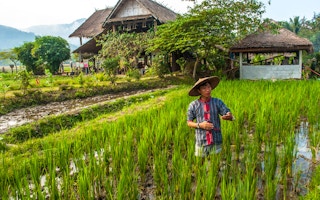Dwindling crop yields, land scarcity and climate change may cause Southeast Asia to lose its status as a major rice exporter — unless changes in production and management techniques are introduced, says an analysis.
Published March in Nature Food, the analysis evaluates the gap between potential and actual yields of rice across Southeast Asian countries, including Cambodia, Indonesia and the Philippines, and shows ways to augment rice production in the region.
Southeast Asia accounts for about 40 per cent of international rice exports but the region is also a substantial consumer of rice. The researchers note that by 2050, owing to increasing populations, there will be an 18 per cent higher demand for rice in the region.
With limited scope in other major rice-producing countries like China and India to generate a rice surplus, Southeast Asian countries with a larger yield gap must step up production to avoid the need for import in the future, the researchers say.
“
Maintaining the capacity of Southeast Asia to produce a large rice surplus can help reduce global price volatility and provide a stable and affordable rice supply to many countries in Sub-Saharan Africa and the Middle East.
Samarendu Mohanty, Asia regional director, International Potato Center
Rice yield stagnation has been noted in countries like Myanmar, Thailand and Vietnam, owing to residential and industrial encroachment on rice-growing areas with little prospect to expand irrigated paddy lands, thanks to inadequate investment and other reasons.
“Our analysis shows that Southeast Asia will not be able to produce a large rice surplus in the future if current trends continue,” says Alice Laborte, an author of the study and senior scientist at the Philippine-based International Rice Research Institute. “Failure to increase yield on existing rice area will drastically reduce the capacity of countries in the region to achieve or sustain rice self-sufficiency and export rice to other regions.”
Using a data-intensive approach the researchers found that the average gap in rice yield represents about 48 per cent of the “yield potential” estimated for the region although there were significant differences among countries. Cambodia, Myanmar, the Philippines and Thailand were showing larger “rice yield gaps” than Indonesia and Vietnam.
Closing the “exploitable yield gap” by half through proper crop management and other measures would drastically reduce the need to import rice and generate an “aggregated annual rice surplus of 54 million tonnes available for export,” the researchers say.
They recommend specific measures to improve the rice yields such as investments in agricultural research and scaling up of productivity-enhancing technologies to narrow the exploitable yield gap over the next 20 years. Crop management practices such as better use of fertiliser and irrigation, nutrients, water, and pest management are particularly useful in lowland rainfed environments, they add.
“Closing of yield gaps requires the concerted effort of policymakers, researchers and extension services to facilitate farmers’ access to technologies, information, and markets,” says Laborte.
Southeast Asia needs to produce more rice with reduced inputs, including land and water, and also leave behind a smaller environmental footprint, says Samarendu Mohanty, Asia regional director of the International Potato Center.
“With consumption still rising along with population growth, these countries need to accelerate yield growth in targeted countries to remain net exporters of rice,” Mohanty tells SciDev.Net.
“Increasing rice production in the region will enhance food security not only in the region but also globally,” Laborte says. “Maintaining the capacity of Southeast Asia to produce a large rice surplus can help reduce global price volatility and provide a stable and affordable rice supply to many countries in Sub-Saharan Africa and the Middle East.”
“With soaring fertiliser prices, many farmers may choose to reduce fertiliser usage which could lead to lower rice production,” she adds.
According to Mohanty, fertiliser prices have skyrocketed in the past several months with the Ukraine war making it even worse; in February alone, fertiliser prices went up by 40 per cent.
“The wet season paddy crop in Asia, [the crop of] the main growing season, which is just a couple of months away, will be severely impacted by high prices and shortages in fertiliser,” says Mohanty.
This article was originally published on SciDev.Net. Read the original article.










